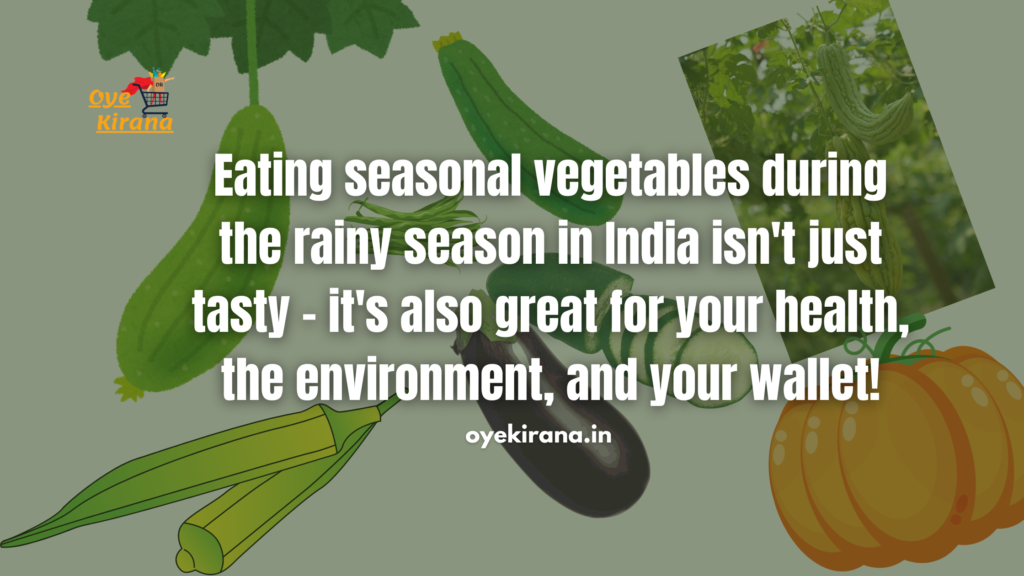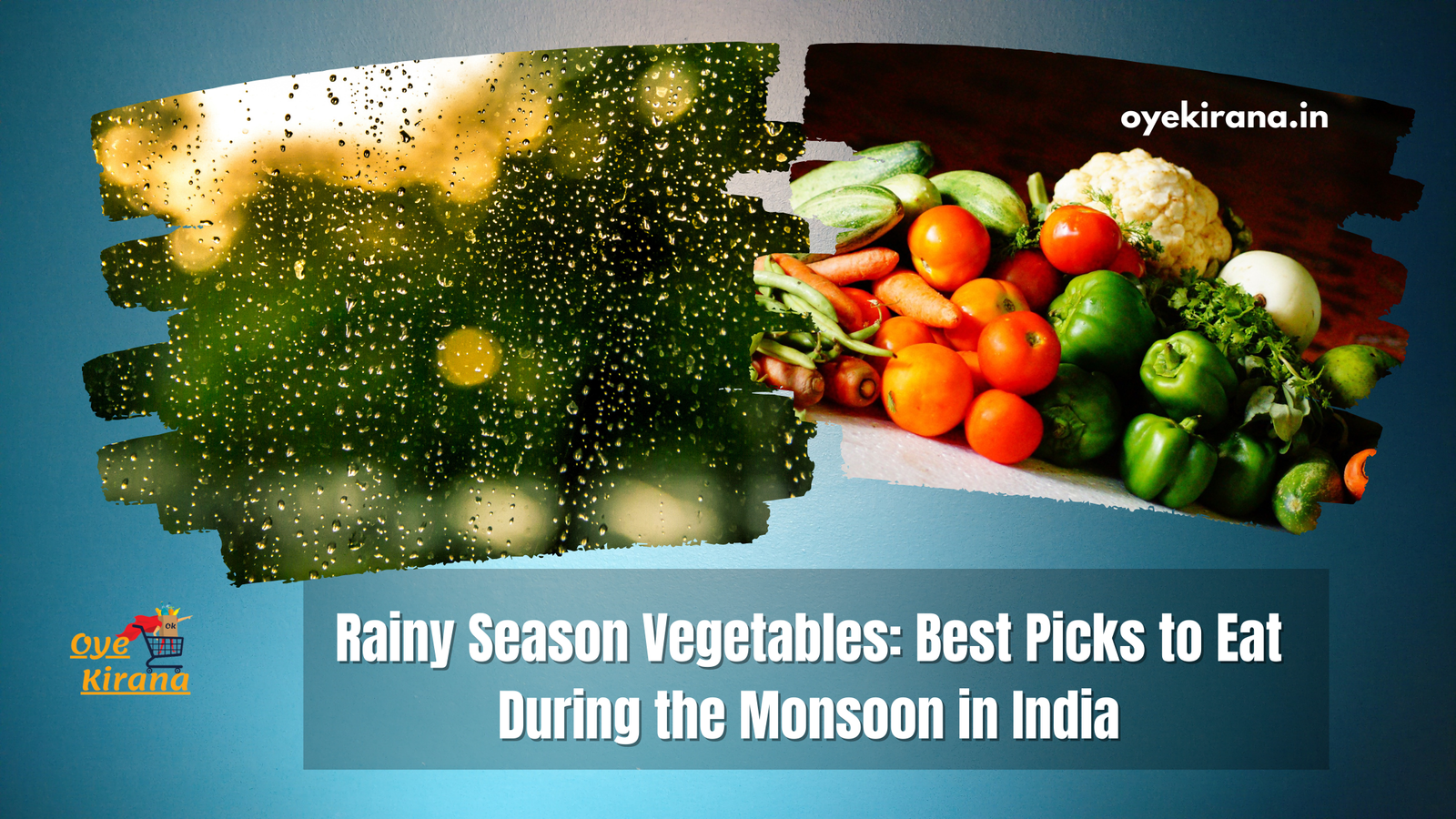Rainy season vegetables in India bring a burst of freshness and flavor to our plates. The monsoon season, which typically lasts from June to September, transforms the landscape into a lush green paradise. During this time, the markets overflow with a variety of vibrant vegetables that thrive in the rainy weather. Embracing these seasonal vegetables is not only delightful but also essential for our health and the environment.
In this blog, we’ll explore some of the best rainy season vegetables you can enjoy in India. From the versatile bottle gourd to the crunchy ridge gourd and the nutritious bitter gourd, we’ll delve into their nutritional benefits, popular dishes, and tips on how to incorporate them into your daily meals.
Get ready to discover why monsoon vegetables are a must-have in your kitchen this rainy season!
Why Should You Eat Seasonal Vegetables?
Eating seasonal vegetables during the rainy season in India isn’t just tasty – it’s also great for your health, the environment, and your wallet! Here’s why you should consider adding these fresh picks to your plate:
- Nutritional advantages: Seasonal vegetables are harvested at their peak, meaning they are loaded with vitamins and minerals that our bodies need. These nutrients help boost our immune system and keep us healthy during the rainy season when colds and flu are more common.
- Better flavor and freshness: When vegetables are in season, they are fresher and tastier because they are picked at the right time and don’t need to travel long distances to reach your table. This freshness enhances their flavor and texture, making your meals more enjoyable.
- Environmental benefits: Choosing seasonal vegetables reduces your carbon footprint. Since these vegetables are grown locally, there is less transportation involved, which means fewer greenhouse gas emissions. Plus, supporting local farmers helps preserve farmland and promotes sustainable agricultural practices.
- Economic benefits: Buying seasonal vegetables that are locally grown can save you money. They are often more affordable because they don’t require expensive storage and transportation costs. By buying directly from farmers or local markets, you also contribute to the local economy and support small-scale agriculture.
Eating seasonal vegetables isn’t just about what’s on your plate – it’s about making a positive impact on your health, community, and the planet.

What Are The Top Rainy Season Vegetables In India?
Curious about which vegetables thrive during India’s rainy season? Here’s a detailed look at some flavorful picks that not only taste great but also pack a punch in terms of nutrition and health benefits:
Bottle Gourd (Lauki)
- Nutritional profile: Bottle gourd is rich in vitamins C and B, potassium, and dietary fiber, making it an excellent choice for maintaining hydration and aiding digestion.
- Health benefits: Its high water content helps keep you hydrated during the humid monsoon months, while the fiber supports digestive health and helps in weight management.
- Popular dishes and cooking tips: Lauki ki sabzi is a popular dish where the vegetable is cooked with spices like cumin and turmeric, enhancing its mild flavor. To retain its nutrients, it’s advisable to peel and deseed the bottle gourd before cooking.
Bitter Gourd (Karela)
- Nutritional profile: Bitter gourd is packed with essential nutrients like vitamins A, C, and K, as well as minerals like iron and calcium. Despite its bitter taste, it offers significant health benefits.
- Health benefits: Known for its blood sugar-regulating properties, bitter gourd helps manage diabetes and enhances insulin sensitivity. It also aids digestion and supports liver health.
- Popular dishes and cooking tips: Bitter gourd can be prepared in various ways, including stuffed with spices and cooked until tender. To reduce bitterness, soak sliced bitter gourd in salted water before cooking.
Ridge Gourd (Turai)
- Nutritional profile: Low in calories but high in dietary fiber, ridge gourd is beneficial for digestive health and weight management. It also provides vitamins C and A.
- Health benefits: Ridge gourd supports heart health by helping to lower cholesterol levels and promotes healthy skin due to its antioxidant properties.
- Popular dishes and cooking tips: Turai chana dal is a popular dish where ridge gourd is cooked with lentils, enhancing its nutritional profile. Removing the ridges before cooking can improve its texture.
Okra (Bhindi)
- Nutritional profile: Okra is rich in vitamins A, C, and K, as well as folate and dietary fiber. Its unique texture and mild flavor make it a versatile ingredient in various cuisines.
- Health benefits: It promotes digestive health by aiding in bowel regularity and supporting the growth of beneficial gut bacteria. Okra also helps in managing blood sugar levels.
- Popular dishes and cooking tips: Bhindi masala is a beloved dish where okra is cooked with onions, tomatoes, and spices. To preserve its crunchiness, avoid overcooking okra.
Pumpkin (Kaddu)
- Nutritional profile: Pumpkin is packed with beta-carotene, which converts into vitamin A in the body. It also provides vitamins C and E, potassium, and dietary fiber.
- Health benefits: It supports eye health, boosts immunity, and aids in weight loss due to its low-calorie content and high fiber.
- Popular dishes and cooking tips: Pumpkin curry and kaddu ka halwa are popular dishes where pumpkin’s natural sweetness shines. Peeling and deseeding pumpkin before cooking is recommended.
Eggplant (Baingan)
- Nutritional profile: Eggplant is low in calories but rich in dietary fiber and antioxidants. It provides vitamins B6 and K, as well as minerals like potassium and manganese.
- Health benefits: It helps lower cholesterol levels, supports brain health, and promotes heart health due to its phytonutrient content.
- Popular dishes and cooking tips: Baingan bharta and baingan fry are classic dishes where eggplant is roasted or fried with spices. Soaking sliced eggplant in salt water before cooking reduces its bitterness.
Cucumber (Kheera)
- Nutritional profile: Cucumber is known for its high water content, which keeps you hydrated during hot and humid weather. It also provides vitamins K and C, and minerals like potassium.
- Health benefits: It supports skin health, aids in hydration, and helps regulate body temperature during the monsoon season.
- Popular dishes and cooking tips: Cucumber raita and cucumber salad are refreshing dishes where cucumber’s crunchiness complements yogurt or dressing. Fresh and crunchy cucumbers should be used for best results.
Drumstick (Sahjan ki Phalli)
- Nutritional profile: Drumstick is rich in vitamins A, C, and B-complex, as well as minerals like calcium, iron, and magnesium.
- Health benefits: It supports bone health, boosts immunity, and aids in digestion due to its fiber content.
- Popular dishes and cooking tips: Drumstick sambar and drumstick curry are popular South Indian dishes where drumsticks are cooked with lentils or spices. Removing fibrous strands before serving enhances its appeal.
Snake Gourd (Chichinda)
- Nutritional profile: Snake gourd is low in calories but rich in dietary fiber, vitamins A and C, and minerals like calcium and iron.
- Health benefits: It aids in digestion, promotes weight loss, and supports overall digestive health due to its fiber and water content.
- Popular dishes and cooking tips: Chichinda chana dal and snake gourd stir-fry are common dishes where snake gourd’s mild flavor shines. Peeling before cooking improves its texture.
Colocasia (Arbi)
- Nutritional profile: Colocasia is rich in carbohydrates, dietary fiber, and vitamins like vitamin C and B-complex.
- Health benefits: It provides sustained energy, aids in digestion, and supports cardiovascular health due to its potassium content.
- Popular dishes and cooking tips: Arbi fry and colocasia curry are dishes where colocasia is boiled or fried and then seasoned with spices. Boiling or frying colocasia before cooking enhances its flavor and texture.
Indian Squash (Tinda)
- Nutritional profile: Indian squash is low in calories but rich in dietary fiber and vitamins A and C.
- Health benefits: It aids in digestion, promotes weight loss, and supports skin health due to its vitamin and fiber content.
- Popular dishes and cooking tips: Tinda masala and stuffed tinda are popular dishes where Indian squash is stuffed with spices and cooked until tender. Cooking until tender brings out its natural sweetness.
Green Beans (Farasbi)
- Nutritional profile: Green beans are rich in vitamins A, C, and K, as well as minerals like iron and calcium.
- Health benefits: They support heart health, aid in digestion, and promote bone health due to their nutrient content.
- Popular dishes and cooking tips: Farasbi bhaji and green bean stir-fry are dishes where green beans are cooked with spices or stir-fried until crisp-tender. Trimming ends and cooking until crisp-tender preserves their nutrients.
These rainy season vegetables not only add variety to your meals but also contribute to your overall well-being. From enhancing flavors to providing essential nutrients, they’re a delicious way to embrace the bounty of the season.
How To Choose The Freshest Rainy Season Vegetables?
Wondering how to pick the best rainy season vegetables? Here are some easy tips to ensure you bring home the freshest produce:
- Look for vibrant colors: Choose vegetables that have bright, vibrant colors as they indicate freshness and optimal ripeness. Avoid dull or faded colors.
- Check for firmness: Gently squeeze the vegetables to check for firmness. They should feel firm and not mushy or soft, which could indicate overripeness.
- Inspect the skin: Ensure the vegetable’s skin is smooth and free from blemishes, cuts, or spots. A smooth skin indicates freshness and quality.
- Consider the weight: Heavier vegetables for their size typically indicate juiciness and denser nutrient content. Lighter vegetables may be dry or less flavorful.
- Smell the aroma: Some vegetables, like cucumbers and tomatoes, should have a mild, fresh aroma. Avoid vegetables with a strong or unpleasant smell.
How Should You Store Rainy Season Vegetables?
Curious about how to keep your rainy season vegetables fresh for longer? Here are some easy tips to maximize their freshness and shelf life:
- Optimal storage conditions: Store vegetables in a cool, dry place away from direct sunlight. Some vegetables like bottle gourd and pumpkin can be kept at room temperature, while others like cucumbers and green beans benefit from refrigeration.
- Use breathable containers: Store vegetables in breathable containers or perforated plastic bags to maintain airflow and prevent moisture buildup, which can lead to spoilage.
- Separate ethylene producers: Keep ethylene-producing vegetables like tomatoes and cucumbers away from ethylene-sensitive ones like potatoes and onions to prevent premature ripening and spoilage.
- Avoid washing before storage: Wash vegetables only before use to prevent them from becoming soggy. Moisture can accelerate decay, so keep them dry until you’re ready to cook.
What Are The Best Practices For Washing During The Monsoon?
Wondering how to safely wash and prepare rainy season vegetables? Here are some best practices to ensure they’re clean and ready to cook:
- Rinse under cold water: Wash vegetables under cold running water to remove dirt, pesticides, and bacteria. Use a vegetable brush for firm-skinned vegetables like cucumbers and ridge gourd.
- Pat dry with a clean towel: After washing, gently pat vegetables dry with a clean kitchen towel or paper towel to remove excess moisture.
- Trim and cut as needed: Trim off any bruised or damaged areas. Cut vegetables as per your recipe’s requirements, ensuring uniform pieces for even cooking.
- Store prepared vegetables properly: If not cooking immediately, store washed and prepared vegetables in airtight containers in the refrigerator to maintain freshness.
How Can You Cook Delicious Meals With Rainy Season Vegetables?
Looking for quick and easy ways to enjoy rainy season vegetables? Here are some simple recipes and cooking ideas that will delight your taste buds:
- Quick and easy recipes: Try stir-frying ridge gourd with spices like cumin and turmeric for a flavorful side dish. Or, make a refreshing cucumber salad with tomatoes, onions, and a squeeze of lemon juice.
- Enhancing flavor and nutrition: Roast or grill vegetables like eggplant and pumpkin to enhance their natural sweetness. Add fresh herbs like coriander or mint to elevate flavors without extra calories.
- Incorporating into daily meals: Use bottle gourd in soups or stews for a light and nutritious meal. Make stuffed bitter gourd with a mix of spices and lentils for a hearty vegetarian dish.
Conclusion
As we conclude our exploration of rainy season vegetables, it’s clear they offer more than just delicious flavors—they’re packed with nutrients that can benefit your health during this rainy season in India. Whether you’re enjoying the hydrating properties of cucumber or the rich vitamins in bitter gourd, these vegetables provide a wholesome addition to your meals.
Let’s continue to embrace these seasonal delights in our cooking. Try out new recipes or stick to traditional favorites. By incorporating more of these vegetables into your diet, you not only support local farmers but also ensure you’re consuming fresh, nutritious food.
Now, it’s your turn! Share your favorite rainy season vegetable recipes or cooking tips in the comments below. Let’s inspire each other to make the most of this bountiful season’s offerings and enjoy every bite!




